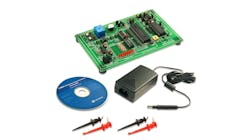Training Kit Improves Education In Electronic Instrumentation
How did you learn electronic test and measurement equipment and processes? If you’re like most engineers, you probably didn’t learn much of it in college since lab time was typically short or non-existent. Also, the emphasis then was on theoretical validation rather than instrument operation, application, specifications, and the importance of measurement methods.
As a result, most of you probably learned how to use a scope, signal generator, spectrum analyzer, and other instruments on the job. Now, Agilent Technologies has introduced a product that should make it faster and easier to learn instruments and measurements today both at college and on the job.
The Agilent U3000A Electronic Instrumentation Training Kit was designed specifically to assist in learning instrument operation and measurement techniques (see the figure). It’s configured to work with the four most common pieces of test equipment that every engineer uses: the digital multimeter (DMM), a power supply, an oscilloscope, and a function generator.
The kit is made up of a PIC microcontroller and a variety of peripherals, such as an analog-to-digital converter (ADC), digital-to-analog converter (DAC), power sources, temperature sensor, 8-bit LED display, buzzer, and relay. Combined with the test instruments, the kit creates a complete system for learning basic instruments and measurements.
Paired with a DMM, the kit helps users learn the basic measurement of voltage, current, and resistance as well as capacitance, frequency, and diode condition. Measurement error and fault finding familiarization are included.
Combined with a power supply, users learn the advantages of switching versus linear supplies, the principles of dc-dc converters and linear supplies, and power-supply protection and measurements. Using a scope brings additional experience in measuring all the basic analog and digital signal characteristics.
An introduction to digital sampling scopes is provided along with measurement techniques. Users can even demo signal displays in the frequency domain using a scope’s fast Fourier transform (FFT) function. Noise filters are introduced as well.
With the function generator, users learn the various operating modes and principles as they compare its output with that of an arbitrary waveform generator. Modulation and swept frequency techniques also are introduced.
The secret to making this kit successful is the complete documentation supplied and the ready-to-run lab experiments that make the professor’s job easier and the student’s task simpler. The experiments are designed around Agilent instruments, but other equipment probably could be used if the instructor makes some adjustments.
If you’re updating your college lab or providing instrumentation instruction to new hires, this may be the answer. It’s worth a look at $199.
About the Author

Louis E. Frenzel
Click here to find more of Lou's articles on Electronic Design.
